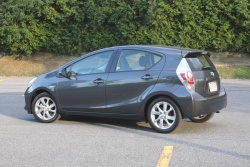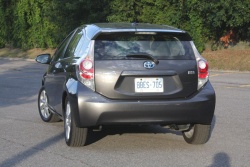 Toyota Prius C Technology. Click image to enlarge |
|
First Drive: 2012 Toyota Prius C
Manufacturer’s web site |
Review and photos by Chris Chase
Photo Gallery:
2012 Toyota Prius C
You could argue that the Toyota Prius is not just a hybrid; it’s “the” hybrid, a car whose name and styling have practically become hallmarks for vehicles powered by a combination of gasoline and electricity.
The Prius already has its fans, including those early adopters who bought into the hybrid hype and took home first- and second-generation versions of this car. But as hybrid technology has improved and prices have continued to drop, their appeal as mainstream vehicles has grown among drivers who once dismissed them as too expensive, in spite of the potential for impressive fuel savings. It doesn’t hurt that the 2012 Prius liftback (the standard design that many can identify by looks alone) is a far cry more advanced than the one that debuted in Canada in 2001, but is $4,000 cheaper than that original model.
Now, Toyota is broadening the Prius’ scope with the addition of two new variants for 2012. Autos.ca has covered one of those cars—the Prius V MPV—extensively, but the other, the subcompact Prius C, is a lesser-known commodity.
   Toyota Prius C Technology. Click image to enlarge |
The C stands for city-centric, as the car’s dimensions are better suited to the tight confines of an urban environment than the larger Prius liftback (and, indeed, the even bigger V). Its small size makes it the most intriguing Prius variant: Toyota has taken a type of car already prized for being inexpensive to run and easy to live with (the subcompact hatchback) and added even more thrift with its Hybrid Synergy Drive powertrain. This is the smallest hybrid on the market, the most fuel efficient (per its Natural Resources Canada ratings of 3.5 L/100 km city and 4.0 L/100 km/h highway) and the least expensive (with a starting price of $20,950).
We were curious what a subcompact hybrid would be like to live with over a longer term than the typical one-week vehicle loan. Toyota was (not surprisingly) happy to satisfy that curiosity, so this Magnetic Grey Metallic Prius C will be on the Autos.ca test fleet through the end of September.
This is one of 10 hybrid models sold by Toyota and its upscale Lexus brand (11 if you count the coming 2013 Lexus ES Hybrid), a number that points to the general trend toward vehicle electrification. Toyota is an influential player in the market for hybrid and electric vehicles, but it’s certainly not alone. Honda was actually first to sell a hybrid car with its original 1997 Insight, but has since lost ground, proof of which can be seen in the underwhelming (and, quite frankly, depressing) current Insight. Ford’s Fusion Hybrid, which is about to move into its second generation, is a fantastic sedan. Hyundai and Kia each have hybrids based on their mid-sized Sonata and Optima sedans. Chevrolet continues to market its Volt as an electric car with extended range, but in reality, it’s basically a hybrid that can be plugged in and driven electrically for short to medium distances. Finally, BMW, Mercedes-Benz, and Porsche each sell hybrid models, though their approach is to use electric power to add performance, rather than to specifically reduce fuel consumption.
We can’t ignore diesels. This is old tech (although electric cars have been around for about as long), but modern compression-ignition motors run cleanly and quietly, and return hybrid-like fuel economy. Right now, the only diesels available here are German in origin, and we suspect that’s the way it will stay, despite the occasional rumours and rumblings from various Japanese and American automakers. (Chevrolet says it will bring a diesel-powered Cruze here next year, but we’ll believe it when we see it.)











